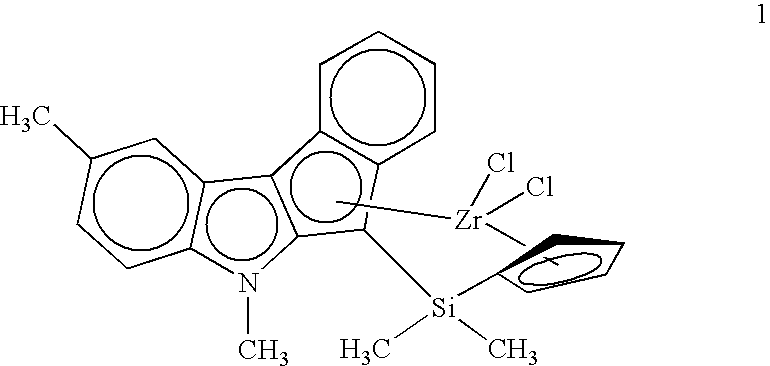Polyolefin compositions
a polyolefin and composition technology, applied in the field of polyolefin compositions, can solve the problems of lack of processability advantages of ziegler resins, limited progress, and large amount of branching for many film applications, and achieves good impact resistance, high stiffness, and easy processing
- Summary
- Abstract
- Description
- Claims
- Application Information
AI Technical Summary
Benefits of technology
Problems solved by technology
Method used
Image
Examples
examples 1-4
Preparation of Ethylene Copolymers
[0030]Each of the copolymers for Examples 1-4 is produced on a pilot-scale, single slurry-loop reactor using a silica-supported dimethylsilyl-bridged cyclopentadienyl(indeno[2,1-b]indolyl)zirconium dichloride complex, 1. The complex is generally prepared and supported by the method of U.S. Pat. No. 6,908,972 (see Examples 3 and 10). A toluene solution of MAO, complex, and F15 activator is added to MAO-treated silica using an incipient-wetness technique as previously described to give a free-flowing powder. Density and melt index targets are adjusted by controlling temperatures, feed rates, comonomer level, and hydrogen concentration. The resulting polyethylene powder is combined with an antioxidant package and pelletized prior to determining physical properties (see Table 1).
[0031]Run conditions: catalyst cycle time (s): 90-280; diluent: isobutane, at feed rate 88-160 pph; temperature: 165-170° F.; 1-hexene / ethylene molar ratio: 0.29-0.33; 1-hexene ...
PUM
| Property | Measurement | Unit |
|---|---|---|
| melt index | aaaaa | aaaaa |
| density | aaaaa | aaaaa |
| phase angle | aaaaa | aaaaa |
Abstract
Description
Claims
Application Information
 Login to View More
Login to View More - R&D
- Intellectual Property
- Life Sciences
- Materials
- Tech Scout
- Unparalleled Data Quality
- Higher Quality Content
- 60% Fewer Hallucinations
Browse by: Latest US Patents, China's latest patents, Technical Efficacy Thesaurus, Application Domain, Technology Topic, Popular Technical Reports.
© 2025 PatSnap. All rights reserved.Legal|Privacy policy|Modern Slavery Act Transparency Statement|Sitemap|About US| Contact US: help@patsnap.com



